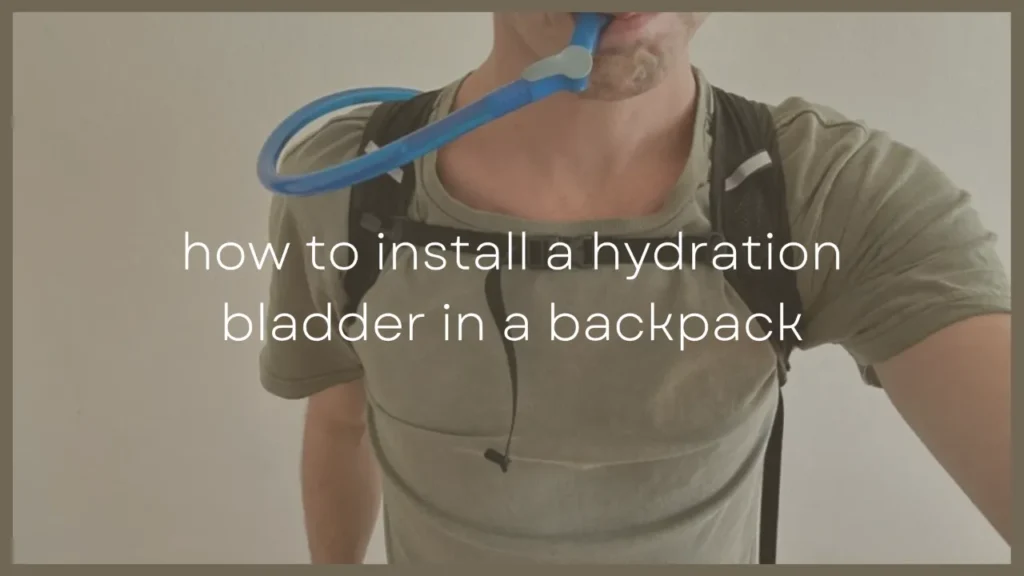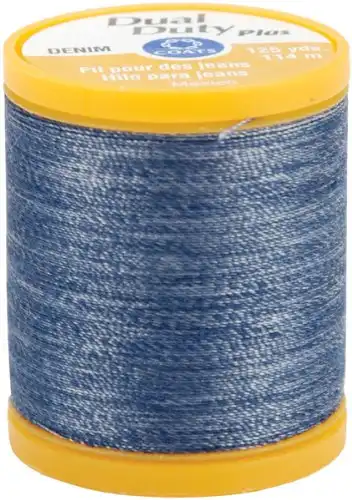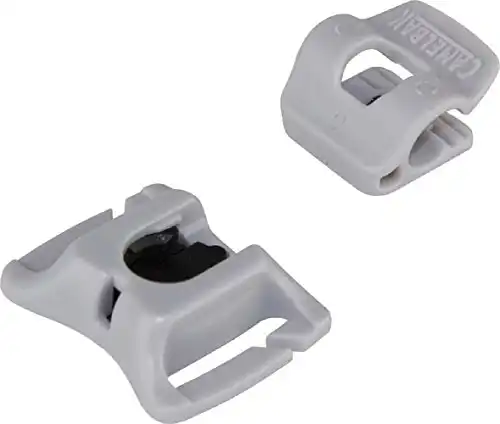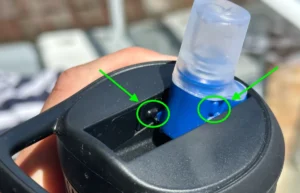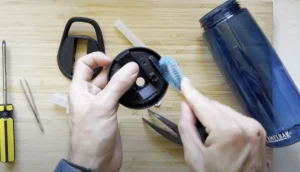Nowadays, most hiking backpacks come with a sleeve in the top interior of the main compartment meant for a hydration bladder.
But if your backpack doesn’t already have a built-in sleeve or you’d like to use a larger bladder than can fit, you’re still in luck — it’s not actually very difficult to install a reservoir in any backpack.
To install a CamelBak bladder loop in your backpack, attach a 5½ inch strand of ½ inch width nylon strap on the top, rear interior of your backpack’s main compartment, leaving about 2 inches between ends.
If your reservoir is suspended by a slot rather than hooks, attach a 4 inch length of 1 inch nylon strap with a quick-release buckle instead.
For a faster, easier installation, simply tie your reservoir to any loop or hook already in your pack using some paracord. It’s not a permanent solution, but it’s much quicker and easier.
Step 1: Choose The Right Place In Your Backpack
Ideally, your hydration pack will be positioned in your backpack where it can hang freely, without bunching.
This will help prevent your delivery tube from kinking, prevent damage to your bladder, and make it much easier to get every last drop of water from your reservoir.
In most backpacks, that means suspending it from the top middle of the main compartment. Though some larger packs may have enough space in a side pocket to fit a small bladder.
Step 2: Prepare Your Materials
Depending on the type of reservoir you have, there are two different methods you may need to use to install your bladder.
Many reservoirs, including CamelBaks, are suspended by two small hooks that secure to a fabric loop. Others have a slot for a hook or strap instead.
If your bladder uses a hooked suspension, like most CamelBaks, prepare a piece of ½ inch width nylon strap (or a similar thin, sturdy material) at least 8 inches in length. It’s more than you’ll really need but it gives some room for error and any excess will be trimmed off later.
If your reservoir suspends from a strap or hook, pick up some 1 inch width nylon utility strap with a small buckle. Cut a piece that’s at least 6 inches in length past the buckle.
Step 4: Attach The Loop Or Strap
The best way to attach the loop or strap to your backpack is with some good old-fashioned thread and needle.
If your sewing skills aren’t quite up to par, don’t worry, it’s pretty basic and surprisingly tough to mess up.
Sewing the loop or strap across a seam or other thicker part of your backpack will help make your suspension more solid and help prevent tears.
Using a stronger thread isn’t mandatory, but will better support the weight of your reservoir.
Dual Duty Plus Denim Thread for Jeans in jeans blue
How To Attach A CamelBak Bladder Loop
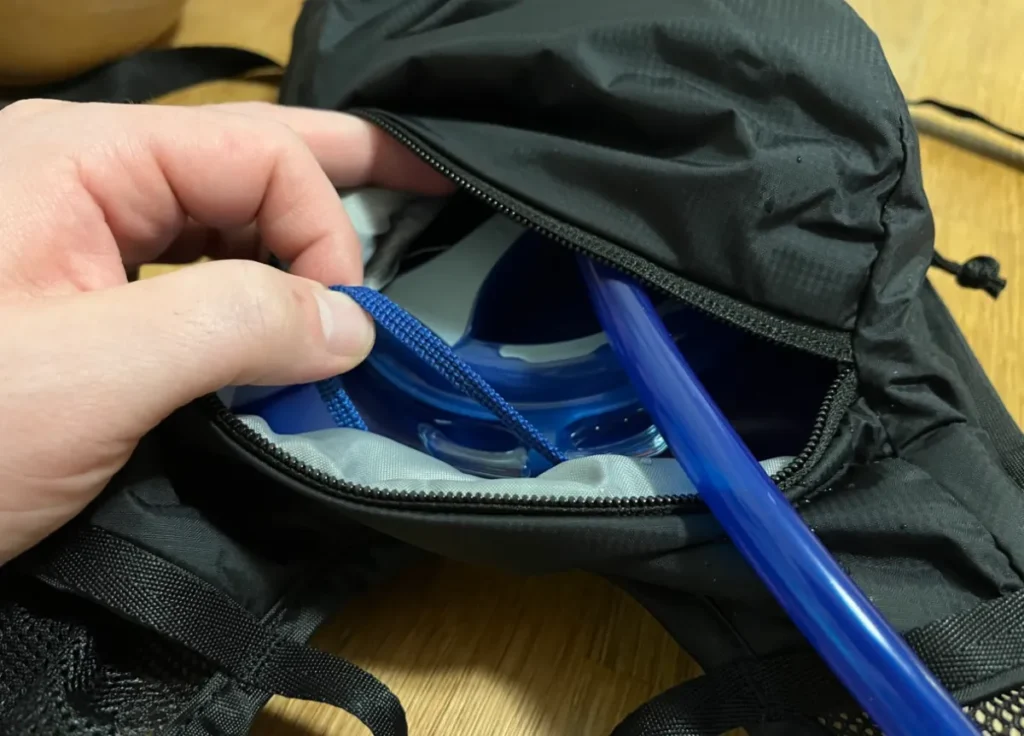
Many reservoirs, including all CamelBaks, are meant to be suspended in your pack by a fabric loop on two lateral-facing hooks.
A CamelBak bladder loop should be about 5½ inches in length with 2 inches between points.
- Find the middle point of the top, back-side interior of your pack and mark using a sharpie or pen.
- Measure 1 inch outward from that midpoint in both directions and make two more small marks.
- Align one end of your 8 inch strand of ½ inch nylon strap flat on one of the two outer marks.
- Thread your needle, double the thread over, and tie a thick knot at the end.
- Push your needle through the strap and backpack and pull the thread all the way through until the knot snags on the opposite end.
- Continue stitching across the width of the strap, doubling, then tripling back across.
- Once the strap is firmly secured, knot the thread tightly and cut off the excess thread.
- Measure 5½ inches from the secured end of your strap and mark.
- Line up the mark on your strap with the opposite outer mark on your backpack.
- Repeat steps 4 through 7 to attach this end.
- Trim away any excess strap.
How To Attach A Strap To Suspend Other Reservoirs
The best way to attach a hydration pack with a slot for a strap or hook is with a short piece of nylon strap, about four inches in length, and a quick-release buckle.
- Determine the middle point of the top, rear interior of your pack, then mark using a sharpie or pen.
- Center an at least 6 inch length of 1 inch width nylon strap vertically over that midpoint, buckle-side up.
- Leave about 1 inch of exposed strap above the area you intend to sew, with the rest hanging below.
- Thread your needle, double the thread over, then tie a thick knot at the end.
- Push your needle through the strap and backpack then pull the thread all the way through until the knot snags.
- Stitch across the entire width of the strap from end to end, doubling, then tripling back across.
- Once the strap is secured, knot the thread tightly and cut off any excess thread.
- If you’re using a two-sided buckle, connect it to the opposite end.
- Trim off any excess strap if you prefer, but I prefer to leave the extra to make adjustments later if needed.
Step 5: Hook Up Your Bladder
To attach your CamelBak reservoir to the loop, place your bladder with the tube-side toward the bottom of your pack. Hook the loop around one of the lateral hooks, then pull tightly across to hook on the opposite end.
To attach a slotted reservoir to your strap, place the reservoir with the tube-side toward the bottom of your pack. Slide the longer end of the strap through the slot, attach the buckle, and pull until it’s snug.
Pull the delivery tube up and out of the pack over one shoulder, securing it in place with your zipper. Connect the tube to a shoulder strap using a tube trap.
Keep your tube in place no matter how bumpy the trail. Tube rotates while magnet stays in place
The Quick And Easy Way To Install A Hydration Bladder In A Backpack
You always have the option of just filling your bladder, sucking the excess air out, and finding a spot to firmly tie your bladder to any loop or hook inside your pack with some paracord.
It’s not a permanent solution, but it works nearly just as well as the method above with a lot less effort required.

